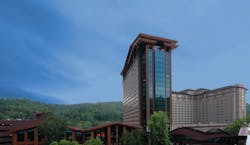Faced with a complete expansion and remodeling effort, the security and surveillance staff at Harrah’s Cherokee Casino & Hotel in North Carolina turned to security systems integrator North American Video (NAV) to provide state- of-the-art video surveillance and access control systems to effectively monitor both the casino and non-gaming attractions. The expansion was part of a major overhaul to the hotel and casino property, which included doubling the size of the legacy gaming space, adding a new hotel tower and complete remodel of existing areas.
The complexity of installing the security system made the job unique, as reflected by the 20-plus different construction phases that would involve closing various sections of the property for a time and coordinating closely with various contractors to install new systems while maintaining a live, operating gaming environment for guests. Multiple trades working in unison ensured minimal downtime.
The three-year-long expansion is nearly complete and the new video surveillance system is already in place, including the full installation of a new video monitoring room, recording solution and system head-end, in addition to adding more than 3,000 cameras. The system uses a hybrid configuration with analog cameras covering most areas with additional IP megapixel cameras to cover “digital” table games.
A Monumental Undertaking
The casino offers 36 table games using real chips and real dealers with virtual cards that are “dealt” by computerized video monitors. Approval is pending with North Carolina to use live card dealers. Besides gaming, the expanded facility offers a 21-story luxury hotel, a covered garage, arcade, indoor pool and workout room, and a 15,000-square-foot conference center.
Before the expansion, Harrah’s Cherokee had an existing relationship with NAV, which had provided the property with video equipment over the years. “We wanted a company that would be there over the long-term,” says Juan Owle, Surveillance Manager.
NAV coordinated with construction personnel and subcontractors to minimize the impact of the expansion on ongoing operations. The surveillance system installation happened during a busy time, but the integrator did a good job of communicating with the other contractors to minimize downtime, Owle says.
“Keeping the existing system and the new system up and running during the changeover was a big challenge, as was the sheer magnitude of the system and the operating environment,” adds Steve Malia, Vice President of Engineering Services and Marketing for NAV. The company was involved from the project’s inception and used a design-build approach to create the system in cooperation with the operations, architectural and interior design teams.
Hybrid Surveillance
The hybrid surveillance system uses Pelco technology, including the Endura 2.0 IP-based recording platform. Pelco’s Sarix 1.3-megapixel cameras provide additional resolution for the digital gaming tables, and they are connected directly to the Endura platform. “We felt like the analog cameras weren’t keeping up with the digital table games, and we wanted to upgrade our viewing capabilities of these tables,” Owle says. Megapixel cameras are also used in some non-gaming areas, such as the “soft-count” cash handling area.
The vast majority of the casino’s 3,500-plus cameras are analog, and they are connected first to a Pelco 9780 matrix switch, whose two nodes provide more than 3,500 inputs and 128 outputs to the Endura platform. Analog cameras are Pelco’s DF5 fixed domes and Spectra 4 pan-tilt-zoom (PTZ) domes.
An advantage of the system is the practice of “pooling” video archiving/storage across multiple units, which Owle considers more fail-safe and secure compared to saving video to a single storage device with direct failover to another device. The pooling approach also enabled the system to take up less valuable square footage than a fully redundant system. Additionally, the streamlined approach required less power consumption, both related to system operation and the high cost of environmental/climate control of areas housing the system.
The expansion and relocation of the video surveillance control room has improved working conditions for system operators. Previously, operators were crowded in a small room alongside the server equipment and sometimes had to move to a different workstation to view video. Now, there is a larger control room, operators have access from each workstation, and there is plenty of space for servers elsewhere.
In addition to viewing the gaming areas and providing security, the surveillance system provides the resort operational advantages. For example, operators can view how many guests are waiting in line or whether employee performance reflects their training. Supervisors can be alerted in real-time to address any customer service issues. Owle emphasizes that security, gaming surveillance and business operation issues “all go hand-in-hand at the end of the day.”
In a property as successful as Harrah’s Cherokee, future growth is always likely, and the new video system is prepared to accommodate whatever the future holds. To ensure an easy pathway to future expansion, the video infrastructure now supports up to 4,500 cameras.
“We wanted something that would be scalable,” Owle says. “We don’t know how big this property will get even five years from now, and we wanted to be prepared on our end. Forward-thinking has prepared us to handle any expansion in the next five to 10 years, whether it’s more restaurants, gaming space, event venues or whatever."
About the Author
Staff Reports
Editorial and news reports authored by the media team from Cygnus Security Media, including SecurityInfoWatch.com, Security Technology Executive magazine and Security Dealer & Integrator (SD&I) magazine.
